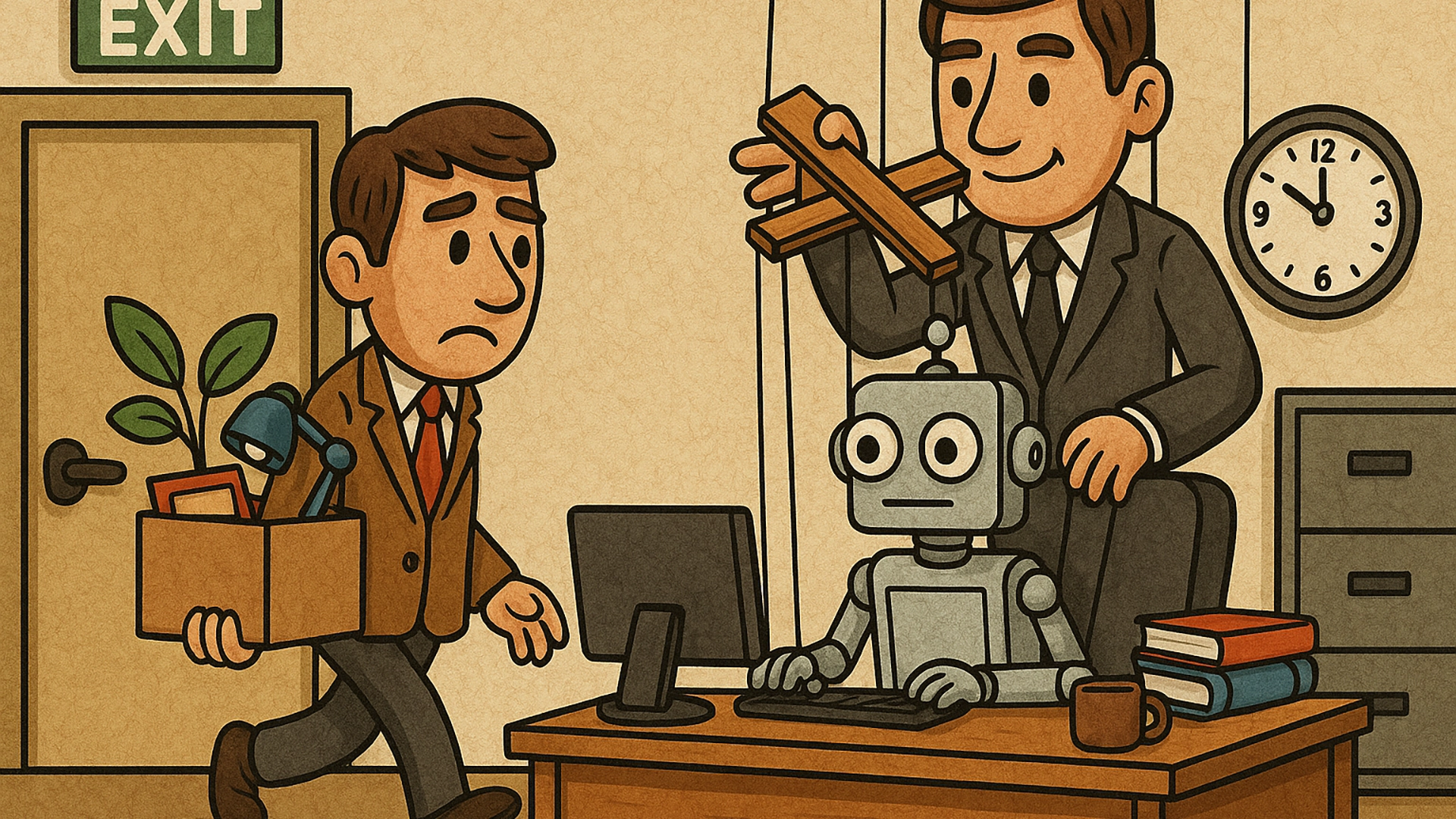
Image generated with ChatGPT
Opinion: AI Systems Vs. The Human Workforce — Real Shift or Just Hype?
A wave of AI-first companies has begun to reshape the corporate landscape, and a new round of layoffs is threatening workers across the globe. While AI technologies have improved and fueled the flames of hype, high-profile failures show that humans are still essential—and may even be rehired.
Since ChatGPT’s debut in 2022, millions of workers around the world have been gripped by uncertainty. Experts—and not-so-experts—have insisted it’s only a matter of time before AI replaces much of the human workforce.
So, is 2025 the year artificial intelligence finally takes over most tasks traditionally performed by people?
Just days ago, following Zoom’s AI-first policy announcement, Duolingo announced that it will also adopt a similar approach, relying increasingly on AI-generated content and tasks and automation while letting go of contractors and more employees.
Duolingo’s CEO compared this new AI-first wave to the mobile-first transformation of the past. And while many companies are eager to ride the wave, others—like McDonald’s, Klarna, and nate—have experienced significant setbacks after fully embracing cutting-edge AI technologies.
Recent studies reveal that AI systems in 2025 are indeed more powerful, but they also hallucinate more frequently—and reach broader audiences than ever before. All of this makes 2025 one of the most confusing and contradictory years yet for the future of the workforce.
Frauds, Errors, And Embarrassing Fails
While many companies are choosing to prioritize AI over human workers for various tasks, it remains to be seen whether this will ultimately prove to be a wise decision. In several high-profile cases, AI has failed—sometimes spectacularly.
In recent days, we’ve witnessed yet another wave of layoffs at major tech companies. Microsoft laid off over 6,000 workers—about 3% of its workforce—, while Amazon cut around 100 jobs in its services and devices, and Google eliminated about 200 positions in partnerships and sales.
Many attribute these layoffs to the increasing use of AI systems to replace staff. However, even if these decisions are directly tied to the adoption of advanced technologies, the true cost and impact of this shift have yet to be determined.
AI Gets Fired Too
McDonald’s and IBM partnered to train AI to take customer orders in drive-thrus—a collaboration announced three years ago—until a series of embarrassing customer experiences went viral on social media. From 260 McNuggets orders to bacon on ice cream, multiple users posted videos showing that McDonald’s AI system couldn’t understand their requests, and even yelling “stop!” didn’t cancel the food selections made by the bot.
In June 2024, McDonald’s issued an internal memo announcing the end of the partnership and the shutdown of the test program, which had been deployed in over 100 restaurants across the U.S.
Of course, McDonald’s AI debacle wasn’t an isolated case. Air Canada’s virtual assistant made headlines last year when it misinformed a customer about bereavement policies. After the passenger purchased two tickets following his grandmother’s death, based on the chatbot’s guidance, he sued the airline. The court ruled in his favor, and Air Canada was ordered to issue a refund. The chatbot has since been removed from the airline’s website, and it is no longer in operation.
Then there are the AI models that simply didn’t perform great as expected. Klarna, one of the early adopters of AI for replacing human customer service roles, announced in 2023 that it had replaced 700 agents with chatbots. Earlier this year, its CEO, Sebastian Siemiatkowski, continued to advocate for AI-driven job replacement and bragged about its success. But just as Klarna’s AI adoption seems successful and steady, the company began rehiring human workers. Turns out that the cheap chatbots provided a “lower quality” service.
“Really, investing in the quality of human support is the way of the future for us,” said Siemiatkowski last week in an interview with Bloomberg, acknowledging that chatbots couldn’t match the quality of human service. The same man who said just months before, in February, that “AI can already do all of the jobs that we, as humans do.”
Humans Pretending To Be AI
The lack of transparency surrounding the performance of generative AI at some companies, such as Klarna, has fueled distrust and raised questions about the true capabilities and achievements of the technology. But some cases go even further.
Companies like nate, a startup that claimed to use AI to power online shopping, have been exposed for hiring humans overseas to pose as AI bots for low wages. Just a few weeks ago, the U.S. Department of Justice revealed that nate’s actual automation rate was 0%.
The company’s CEO, Albert Saniger, raised over $50 million in funding for its supposedly groundbreaking technology, hired data scientists, AI tools, and experts—but failed to disclose to investors that he had also hired hundreds of workers in the Philippines to manually carry out the tasks AI was supposed to perform.
A Better Technology That Still Hallucinates
The other major threat that seems to have no solution is hallucinations. No matter how much models from Google, OpenAI, xAI, Anthropic, or Perplexity improve and release new tools with impressive capabilities, the errors they generate are sparking widespread discussion.
Every week, there seems to be a new case of chatbot hallucination. A few days ago, it was Google with its AI Overviews tool explaining fake idioms—that was hilarious, I must admit—, and recently, Grok sharing false data about a “white genocide” in South Africa.
The hallucination crisis has been affecting—or infecting?—every industry now. It’s a growing concern in the U.S. courts, where AI-generated misinformation has led to legal trouble and expensive fines for law firms, and it’s even impacting the medical field. From the courts to social media, to customer service, and even to technology companies themselves.
“Despite our best efforts, they will always hallucinate,” said Amr Awadallah, the chief executive of the startup Vectara and a former Google executive, to the New York Times in a recent report. “That will never go away.”
The Real Threat To The Workforce
The arrival of AI agents, along with the considerable improvements tech companies have made to AI tools, has led companies like Zoom and Duolingo to announce new measures prioritizing and adopting the technology over workers.
However, companies like McDonald’s, nate, and even Klarna also serve as major examples that, despite the enthusiasm and the significant investment of time and money, AI is still not capable of replacing humans entirely.
We could say that both the shift and the hype are real, after all. But understanding that the people responsible for the adoption, development, layoffs, and hiring of AI models are humans—who have great influence over both the consequences for the future of work and the perception of what is truly happening—leads us to ask:
Is the real threat to the future of work AI itself, or is it the people making the crucial market decisions?


 Previous Story
Previous Story

 Latest articles
Latest articles 